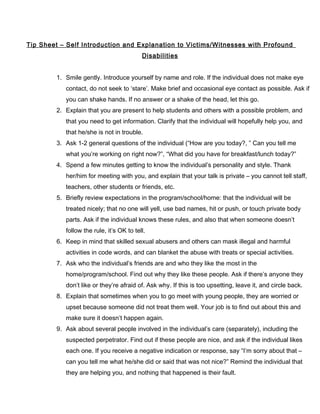
Tip Sheet
- 1. Tip Sheet – Self Introduction and Explanation to Victims/Witnesses with Profound Disabilities 1. Smile gently. Introduce yourself by name and role. If the individual does not make eye contact, do not seek to ‘stare’. Make brief and occasional eye contact as possible. Ask if you can shake hands. If no answer or a shake of the head, let this go. 2. Explain that you are present to help students and others with a possible problem, and that you need to get information. Clarify that the individual will hopefully help you, and that he/she is not in trouble. 3. Ask 1-2 general questions of the individual (“How are you today?, ” Can you tell me what you’re working on right now?”, “What did you have for breakfast/lunch today?” 4. Spend a few minutes getting to know the individual’s personality and style. Thank her/him for meeting with you, and explain that your talk is private – you cannot tell staff, teachers, other students or friends, etc. 5. Briefly review expectations in the program/school/home: that the individual will be treated nicely; that no one will yell, use bad names, hit or push, or touch private body parts. Ask if the individual knows these rules, and also that when someone doesn’t follow the rule, it’s OK to tell. 6. Keep in mind that skilled sexual abusers and others can mask illegal and harmful activities in code words, and can blanket the abuse with treats or special activities. 7. Ask who the individual’s friends are and who they like the most in the home/program/school. Find out why they like these people. Ask if there’s anyone they don’t like or they’re afraid of. Ask why. If this is too upsetting, leave it, and circle back. 8. Explain that sometimes when you to go meet with young people, they are worried or upset because someone did not treat them well. Your job is to find out about this and make sure it doesn’t happen again. 9. Ask about several people involved in the individual’s care (separately), including the suspected perpetrator. Find out if these people are nice, and ask if the individual likes each one. If you receive a negative indication or response, say “I’m sorry about that – can you tell me what he/she did or said that was not nice?” Remind the individual that they are helping you, and nothing that happened is their fault.
- 2. 10.If specific activities or locations are mentioned, ask about these in gentle detail. If an activity seems ‘normal’ but the individual is upset or concerned, find out exactly what happens in that specific activity. (I.e. “OK, so Joe drove you to your OT appointment. You seem not happy about that. What happened when Joe drove you?” or “When you and Doreen had a picnic, what did you do on the picnic?” 11.If the individual becomes too upset, move to another issue or person and then circle back. 12.Remind the individual that part of your job is to make sure that they are safe, happy and treated well all the time. 13. Remind the individual that your talk is private. Tell them that if they have more things to talk about or if they worry, they should ask (a trusted staff or liaison) to call you again. (Note: this will afford some protection to the individual, who may be questioned about the meeting afterwards. If staff/the family know that you can return, they most likely will take more care. 14. Thank the individual for talking with you and tell them that they did a good job and helped you. @Mary E. Wambach2014
